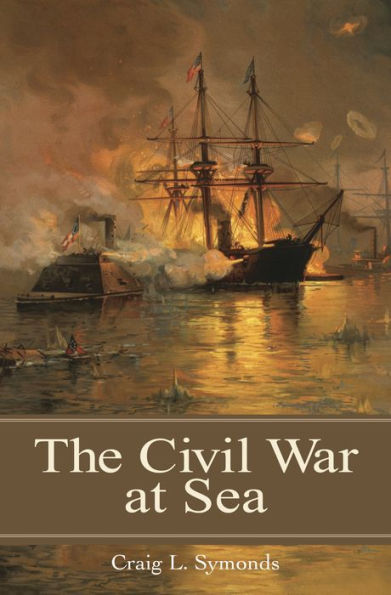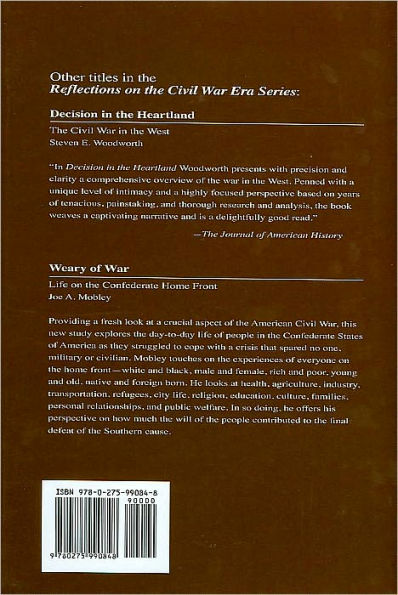"There was a time only several decades past when new histories of the blue-and-brown water US Civil War were hard
to come by. Students and others seeking details of the naval or riverine operations of the great conflict were forced to
rely on old standbys published at the end of the 19th century, some memoirs, several rather popular chronicles, and the
Navy official records. Now, within a span of three years, two excellent operational histories have appeared, both demonstrating the impact of the sea services upon the outcome of the struggle. The first was Spencer C. Tucker's
Blue & Gray Navies: The Civil War Afloat (2006) and the other is this work, from the prize-winning author of last
year's Lincoln and His Admirals (2008). Crisp writing, incisive assessments of leading personalities, and attention to details often overlooked enhance Symonds's book. The author footnotes each of the six chapters, includes good maps, and provides the obligatory photos needed for a Civil War title. A bibliographical essay completes the concise survey. Summing Up: Highly recommended. Undergraduates and Civil War buffs."
"The role of ships during the Civil War is, for most people, confined to the blockade of the cotton exports in the Carolinas and the battle between the ironclads Monitor and Merrimac. Symonds (American History, U.S. Naval Academy, Annapolis MD, emeritus) covers both these subjects and much more. Steam engines and iron-plated hulls were new technologies
at the time, changing the context of sea battles. The encounters are chronicled, with maps and diagrams and the strategic side of the war at sea is explained. However, Symonds also recreates the personalities of the seamen from admirals to deckhands. One lesser known tactic that he discusses is the Confederate response to the blockade, which was the
honored tradition of privateering. Union merchant ships were attacked off the coast of France and England. The Shenandoah sailed literally around the world, hampering trade as far as China and Japan. Symonds presents a side of Civil War history rarely, if ever, included in Civil War accounts."
Reference & Research Book News
"Symonds writes briskly and with great competence, and The Civil War at Sea (and on the rivers) is a masterful overview of a most meaningful topic."
"Symonds' account of the campaigns, strategies, tactics, and personalities that characterized the naval conflict is both detailed and comprehensible for laypersons. He effectively places the naval war within the broader context of an emerging industrial age, as steam and steel led to great changes in the construction and use of warships. The author uses a topical approach, with his descriptions of the Union blockade and Confederate efforts to thwart it particularly interesting. A good addition to Civil War collections."
Symonds, professor emeritus of history at the U.S. Naval Academy, combines his expertise as a scholar of both sea power and the Civil War in this study of an aspect of the conflict largely neglected until now (James McPherson’s War on the Waters comes out in September). Symonds covers the operational history of navies that on both sides were products of improvisation. Synergizing chronology and themes, the text begins by discussing the effect of the mid-century technological revolution. Steam engines, armor plate, and rifled cannon shaped both the war on the high seas and a riverine/littoral dimension unique in naval history. The Confederacy, Symonds says, was initially more creative, introducing ironclads, torpedoes, and a submarine. Southern commerce raiders devastated Union shipping, The Union’s repeated failures before the first battle of Charleston showed a ship could still be a fool to fight a fort. But the new technology of naval war eventually enabled the Union to overwhelm or bypass even complex, well-sited defenses. The Union blockade, though never complete, contributed heavily to the South’s “ growing sense of isolation and eventually depression, both economic and psychological.” Sea power, itself not decisive, significantly influenced the Civil War ’s duration and trajectory, concludes Symonds in this substantive analysis. 24 b&w illus., 4 maps. (Oct.)
"Well written, fast paced, and illustrated with a number of fine maps...this book provides a perfect offing for the general reader who wants to explore the Civil War at sea. However, scholars too should pay close attention, for...Symonds challenges us to think about the struggle [at sea and on the rivers] in new ways. Here we have the best in history—readable, informative, and provocative."—Historian
"Symonds writes briskly and with great competence, and The Civil War at Sea (and on the rivers) is a masterful overview of a most meaningful topic."—Naval History
"Excellent....Crisp writing, incisive assessments of leading personalities, and attention to details often overlooked enhance Symonds's book."—CHOICE
"Symond's account of the campaigns, strategies, tactics, and personalities that characterized the naval conflict is both detailed and comprehensible for laypersons. He effectively places the naval war within the broader context of an emerging industrial age, as steam and steel led to great changes in the construction and use of warships. The author uses a topical approach, with his descriptions of the Union blockade and Confederate efforts to thwart it are particularly interesting. A good addition to Civil War collections."—Booklist
"Covering river and sea, tradition and technology, strategy and happenstance, admirals and sailors, this is as comprehensive and authoritative a book as has ever been written on the naval side of the Civil War. Craig Symonds' hand at the tiller guarantees superb scholarship and lucid prose. All hands aboard!"—Harold Holzer, Chairman of The Lincoln Bicentennial Foundation
"Craig Symonds combines his talents as a fine historian of the U.S. Navy and of the Civil War to produce this outstanding study of the Union and Confederate navies. Focusing on the ways in which Southern technological innovations and Northern industrial productivity shaped the strategy and tactics of the naval war, he offers important insights on the course and outcome of the conflict."—James M. McPherson
"Distinguished naval historian Craig Symonds' well-researched and engagingly written overview, The Civil War at Sea , touches all the major areas of the naval war, including the ships and their guns, the differing strategies pursued by the North and South, and the contest that ensued. Simply put, it is a splendid introduction to the naval side of the conflict."—Spencer C. Tucker
"The Civil War at Sea is crisp and well written, well researched and insightful as well as a timeless contribution to that neglected aspect of Civil War literature."—B. Franklin Cooling
"This is a superb read that melds emerging technology and captivating personalities, both of which continue to mold the U.S. Navy to this day. Craig Symonds masterfully brings this largely overlooked piece of our country's history to life, in a fine book that will appeal to a wide range of interests."—Admiral Bruce DeMars, USN (Ret)
"Craig Symonds' timely and readable tour-de-force, detailing the actions of the U.S. and Confederate navies, sheds new light on both well-known strategies, battles, and personalities as well as on those less well known. Here is a book for Civil War buffs and those looking for good history."—Vice Admiral Robert F. Dunn, USN (Ret), and President of the Naval Historical Foundation
"Symonds has a gift for making complex and technical issues easy to understand, and his straightforward style makes for enjoyable reading. This book will appeal to general readers interested in either U.S. naval history or naval aspects of the Civil War. His thematic structure allows readers to understand the big picture of naval tactics and strategy without being overwhelmed by minutiae."—Library Journal
"[A] comprehensive and outstanding history of the Navy during that period...Symonds' book provides an excellent introduction and an insightful look at naval strategy and technology for those familiar with the naval war and those who have devoted their Civil War study to armies and land battles."—ivil War News
Lincoln Prize-winner Symonds (Lincoln and His Admirals) examines naval strategies and tactics as illustrated by the Civil War, rather than presenting a history of the naval war itself. He tells three basic stories. The first details how technology changed the way navies fought in the Civil War. The most important technological developments included rifled guns and explosive shells, protective iron plating, and advances in steam propulsion with screw propellers. Second, Symonds analyzes Union blockading efforts and Confederate responses as well as Confederate commerce raiding and Union responses, devoting special attention to the effectiveness of overall strategy. The third story, over the last three chapters, is about combined actions and cooperation with ground forces, with accounts of action around Charleston, Mobile, and Wilmington. VERDICT Symonds has a gift for making complex and technical issues easy to understand, and his straightforward style makes for enjoyable reading. This book will appeal to general readers interested in either U.S. naval history or naval aspects of the Civil War. His thematic structure allows readers to understand the big picture of naval tactics and strategy without being overwhelmed by minutiae.—MF









